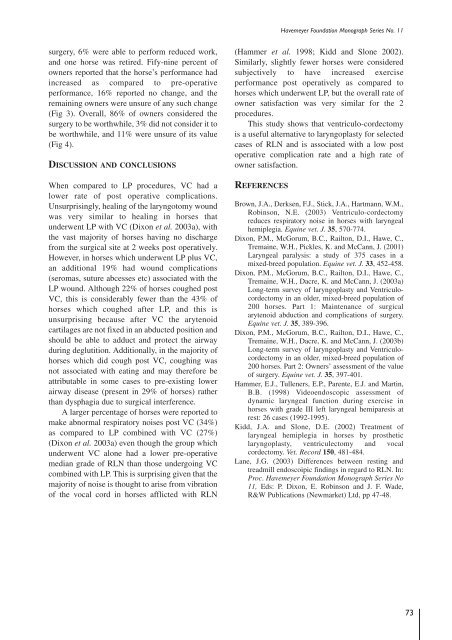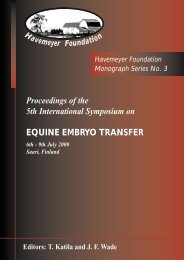Proceedings of a Workshop on - The Havemeyer Foundation
Proceedings of a Workshop on - The Havemeyer Foundation
Proceedings of a Workshop on - The Havemeyer Foundation
Create successful ePaper yourself
Turn your PDF publications into a flip-book with our unique Google optimized e-Paper software.
<strong>Havemeyer</strong> Foundati<strong>on</strong> M<strong>on</strong>ograph Series No. 11<br />
surgery, 6% were able to perform reduced work,<br />
and <strong>on</strong>e horse was retired. Fify-nine percent <str<strong>on</strong>g>of</str<strong>on</strong>g><br />
owners reported that the horse’s performance had<br />
increased as compared to pre-operative<br />
performance, 16% reported no change, and the<br />
remaining owners were unsure <str<strong>on</strong>g>of</str<strong>on</strong>g> any such change<br />
(Fig 3). Overall, 86% <str<strong>on</strong>g>of</str<strong>on</strong>g> owners c<strong>on</strong>sidered the<br />
surgery to be worthwhile, 3% did not c<strong>on</strong>sider it to<br />
be worthwhile, and 11% were unsure <str<strong>on</strong>g>of</str<strong>on</strong>g> its value<br />
(Fig 4).<br />
DISCUSSION AND CONCLUSIONS<br />
When compared to LP procedures, VC had a<br />
lower rate <str<strong>on</strong>g>of</str<strong>on</strong>g> post operative complicati<strong>on</strong>s.<br />
Unsurprisingly, healing <str<strong>on</strong>g>of</str<strong>on</strong>g> the laryngotomy wound<br />
was very similar to healing in horses that<br />
underwent LP with VC (Dix<strong>on</strong> et al. 2003a), with<br />
the vast majority <str<strong>on</strong>g>of</str<strong>on</strong>g> horses having no discharge<br />
from the surgical site at 2 weeks post operatively.<br />
However, in horses which underwent LP plus VC,<br />
an additi<strong>on</strong>al 19% had wound complicati<strong>on</strong>s<br />
(seromas, suture abcesses etc) associated with the<br />
LP wound. Although 22% <str<strong>on</strong>g>of</str<strong>on</strong>g> horses coughed post<br />
VC, this is c<strong>on</strong>siderably fewer than the 43% <str<strong>on</strong>g>of</str<strong>on</strong>g><br />
horses which coughed after LP, and this is<br />
unsurprising because after VC the arytenoid<br />
cartilages are not fixed in an abducted positi<strong>on</strong> and<br />
should be able to adduct and protect the airway<br />
during deglutiti<strong>on</strong>. Additi<strong>on</strong>ally, in the majority <str<strong>on</strong>g>of</str<strong>on</strong>g><br />
horses which did cough post VC, coughing was<br />
not associated with eating and may therefore be<br />
attributable in some cases to pre-existing lower<br />
airway disease (present in 29% <str<strong>on</strong>g>of</str<strong>on</strong>g> horses) rather<br />
than dysphagia due to surgical interference.<br />
A larger percentage <str<strong>on</strong>g>of</str<strong>on</strong>g> horses were reported to<br />
make abnormal respiratory noises post VC (34%)<br />
as compared to LP combined with VC (27%)<br />
(Dix<strong>on</strong> et al. 2003a) even though the group which<br />
underwent VC al<strong>on</strong>e had a lower pre-operative<br />
median grade <str<strong>on</strong>g>of</str<strong>on</strong>g> RLN than those undergoing VC<br />
combined with LP. This is surprising given that the<br />
majority <str<strong>on</strong>g>of</str<strong>on</strong>g> noise is thought to arise from vibrati<strong>on</strong><br />
<str<strong>on</strong>g>of</str<strong>on</strong>g> the vocal cord in horses afflicted with RLN<br />
(Hammer et al. 1998; Kidd and Sl<strong>on</strong>e 2002).<br />
Similarly, slightly fewer horses were c<strong>on</strong>sidered<br />
subjectively to have increased exercise<br />
performance post operatively as compared to<br />
horses which underwent LP, but the overall rate <str<strong>on</strong>g>of</str<strong>on</strong>g><br />
owner satisfacti<strong>on</strong> was very similar for the 2<br />
procedures.<br />
This study shows that ventriculo-cordectomy<br />
is a useful alternative to laryngoplasty for selected<br />
cases <str<strong>on</strong>g>of</str<strong>on</strong>g> RLN and is associated with a low post<br />
operative complicati<strong>on</strong> rate and a high rate <str<strong>on</strong>g>of</str<strong>on</strong>g><br />
owner satisfacti<strong>on</strong>.<br />
REFERENCES<br />
Brown, J.A., Derksen, F.J., Stick, J.A., Hartmann, W.M.,<br />
Robins<strong>on</strong>, N.E. (2003) Ventriculo-cordectomy<br />
reduces respiratory noise in horses with laryngeal<br />
hemiplegia. Equine vet. J. 35, 570-774.<br />
Dix<strong>on</strong>, P.M., McGorum, B.C., Railt<strong>on</strong>, D.I., Hawe, C.,<br />
Tremaine, W.H., Pickles, K. and McCann, J. (2001)<br />
Laryngeal paralysis: a study <str<strong>on</strong>g>of</str<strong>on</strong>g> 375 cases in a<br />
mixed-breed populati<strong>on</strong>. Equine vet. J. 33, 452-458.<br />
Dix<strong>on</strong>, P.M., McGorum, B.C., Railt<strong>on</strong>, D.I., Hawe, C.,<br />
Tremaine, W.H., Dacre, K. and McCann, J. (2003a)<br />
L<strong>on</strong>g-term survey <str<strong>on</strong>g>of</str<strong>on</strong>g> laryngoplasty and Ventriculocordectomy<br />
in an older, mixed-breed populati<strong>on</strong> <str<strong>on</strong>g>of</str<strong>on</strong>g><br />
200 horses. Part 1: Maintenance <str<strong>on</strong>g>of</str<strong>on</strong>g> surgical<br />
arytenoid abducti<strong>on</strong> and complicati<strong>on</strong>s <str<strong>on</strong>g>of</str<strong>on</strong>g> surgery.<br />
Equine vet. J. 35, 389-396.<br />
Dix<strong>on</strong>, P.M., McGorum, B.C., Railt<strong>on</strong>, D.I., Hawe, C.,<br />
Tremaine, W.H., Dacre, K. and McCann, J. (2003b)<br />
L<strong>on</strong>g-term survey <str<strong>on</strong>g>of</str<strong>on</strong>g> laryngoplasty and Ventriculocordectomy<br />
in an older, mixed-breed populati<strong>on</strong> <str<strong>on</strong>g>of</str<strong>on</strong>g><br />
200 horses. Part 2: Owners’ assessment <str<strong>on</strong>g>of</str<strong>on</strong>g> the value<br />
<str<strong>on</strong>g>of</str<strong>on</strong>g> surgery. Equine vet. J. 35, 397-401.<br />
Hammer, E.J., Tulleners, E.P., Parente, E.J. and Martin,<br />
B.B. (1998) Videoendoscopic assessment <str<strong>on</strong>g>of</str<strong>on</strong>g><br />
dynamic laryngeal functi<strong>on</strong> during exercise in<br />
horses with grade III left laryngeal hemiparesis at<br />
rest: 26 cases (1992-1995).<br />
Kidd, J.A. and Sl<strong>on</strong>e, D.E. (2002) Treatment <str<strong>on</strong>g>of</str<strong>on</strong>g><br />
laryngeal hemiplegia in horses by prosthetic<br />
laryngoplasty, ventriculectomy and vocal<br />
cordectomy. Vet. Record 150, 481-484.<br />
Lane, J.G. (2003) Differences between resting and<br />
treadmill endoscoipic findings in regard to RLN. In:<br />
Proc. <strong>Havemeyer</strong> Foundati<strong>on</strong> M<strong>on</strong>ograph Series No<br />
11, Eds: P. Dix<strong>on</strong>, E. Robins<strong>on</strong> and J. F. Wade,<br />
R&W Publicati<strong>on</strong>s (Newmarket) Ltd, pp 47-48.<br />
73








